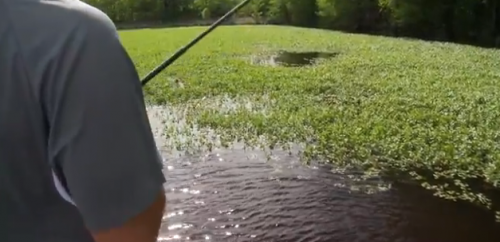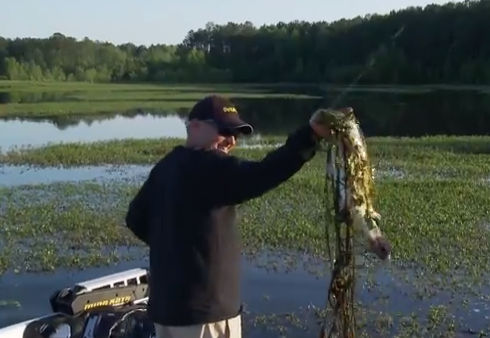If you were to take the average growth cycle of aquatic vegetation nationally, you’d find that most of the grass/ weeds in your favorite lakes, rivers, and ponds are topped out and mature around July. Good news: the bass live there too! It’s a great time to target vegetation as a pattern, especially matted vegetation. It’s not like there is a bad time to fish for bass around aquatic veggies, bass almost always live around the green stuff, it’s just that grass mat fishing and July go hand in hand. In general, matted veggies harbor a slew of summer activity for the entire ecosystem, but the bottom line is that some of the largest bass never leave sight of the mat. The reason is that it’s a home for the bulk of their forage, a refuge for them in all weather, and a hideout from any potential harm. From an angler’s standpoint, the bass strikes that occur from a summer grass mat are no less vicious than a shark mauling. To sum it up- it’s a lot of fun! So here’s a few attack strategies to go after them with:
Weather plays a large part in how bass relate to mats. High pressure sunny days tuck them in the deepest parts of the mats and vegetation holes, while overcast rainy conditions allow them to roam. If they’re buried under the thick stuff due to the bright sun, it’s time to punch. The new Culprit Incredi-punch is a perfect tool for reaching the caverns under the mats. It’s body is compact, durable, and action-packed while still accepting larger flippin’ hooks. The appendages are short so that the bass eat the whole bait in one gulp. The appendages are also oriented so that they open up as extra attractors once penetrated through the mat. Don’t be afraid to use a stout hook, a big 1 ounce or heavier tungsten weight, and some heavy braided line with a flippin’ rod/ reel. Search for productive areas by punching portions every five feet or so along the mat. Then once you get a few bites, hone your approach by punching every two feet or so. It doesn’t hurt to make repeated pitches to the same spot if the area is hot. What you have to keep in mind is that there are numerous caverns that you penetrate with each pitch, so although you may have hit the spot before, your bait may not reach the exact spot the bass is in under each piece of mat. You may have to do some convincing on tougher days. The first drop may get their attention, then the subsequent drops aggravate them enough to strike. Generally speaking, the mats that are located in strategic areas like grass points and bottom depressions are usually better, but a great mat (in any location) also has lush, green and thriving vegetation underneath.
If the forecast calls for rainy or overcast conditions, then that opens up a whole new can of worms (no pun intended). The low light expands the strike zone of the bass and increases their aggression level, so a good bet is to cover the water faster and not worry so much about precise casts. This gives you many more options in terms of bait selections. Swim jigs with Culprit DW3 trailers swam along the grass edges and points, swimming a Culprit Fat Max worm with a light weight over top of the grass, or even casting a Texas rigged Original Culprit worm over submerged and sparse grass clumps adjacent to the mats are all great choices. The biggest key is to keep the baits moving and fish faster. If the spot gives up a few decent fish quickly, don’t spend too much time milking the same spot. Keep moving! Chances are you’ll find more aggressive fish in a short time. Bass (and bass anglers) have to take advantage of those roaming/ feeding conditions around the grassy areas because the next day may be super hot with intolerable bright sun. The only light the bass will see from under the mat on those sunny days will be from when the angler’s Incredi-punch pops through in front of their nose! Either way, you’re covered.

